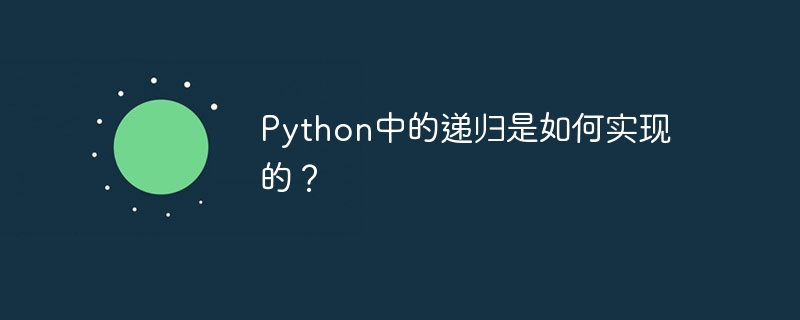Home >Backend Development >Python Tutorial >How is recursion implemented in Python?
How is recursion implemented in Python?
- PHPzOriginal
- 2023-10-25 10:03:171557browse

How is recursion implemented in Python?
Recursion is a technique commonly used in algorithm design, which can decompose a problem into smaller similar problems and solve them by continuously calling itself. In Python, recursive functions can concisely implement this decomposition and calling process, making the code clearer and easier to understand. This article will introduce how recursion is implemented in Python and provide specific code examples.
In Python, the basic structure of a recursive function is as follows:
def recursive_func(...)
if base_case:
# 处理基本情况
return ...
else:
# 将问题分解成更小的同类问题
...
# 通过递归调用解决子问题
...
# 合并子问题的解并返回结果
return ...The core of a recursive function lies in two parts: the base case and the recursive call. The base case refers to the situation where the result can be obtained directly, while the recursive call breaks the problem into smaller sub-problems of the same type and solves the sub-problems by continuously calling itself. Finally, we need to combine the solutions to the subproblems and return the final result.
Below we use two specific examples to illustrate the implementation of recursive functions in Python.
The first example is to calculate the sum of a list of integers. Suppose we have a list of integers [1, 2, 3, 4, 5], we can use a recursive function to calculate the sum of this list.
def sum_list(lst):
if len(lst) == 0:
return 0
else:
return lst[0] + sum_list(lst[1:])In the above code, the basic situation is that when the list is empty, 0 is returned directly. Otherwise, we add the first element of the list to the sum of the remainder of the list and compute the sum of the remainder of the list by calling sum_list recursively. Finally, the two results are combined.
The second example is to calculate the factorial of an integer. We can do this using recursive functions.
def factorial(n):
if n == 0:
return 1
else:
return n * factorial(n - 1)In the above code, the basic situation is that when n is 0, 1 is returned directly. Otherwise, we multiply n by factorial(n - 1) and calculate n - 1 by recursively calling factorial factorial. Finally, the two results are combined.
The above are the basic methods and examples of implementing recursion in Python. Recursion can help us solve some complex problems, but we need to be careful to avoid infinite recursion, which may cause the program to crash. When writing recursive functions, you also need to ensure that the base case is satisfied and that each recursive call reduces the size of the problem. Only in this way can the correctness and effectiveness of the recursion be guaranteed.
To summarize, recursion in Python is achieved through the steps of defining recursive functions, handling basic situations, decomposing the problem, recursively calling and merging solutions to sub-problems. Mastering the principles and writing methods of recursion is very important to solve certain problems, but it also needs to be used with caution to avoid program performance degradation or infinite recursion.
The above is the detailed content of How is recursion implemented in Python?. For more information, please follow other related articles on the PHP Chinese website!
Related articles
See more- Use css3 to implement various triangle style collections in web pages (principle analysis)
- How to draw a Christmas tree using python? (detailed code explanation)
- What are the characteristics of recursive programs?
- How to implement summation of categories and summaries in excel
- How to achieve centering effect in html web pages (code sharing)

